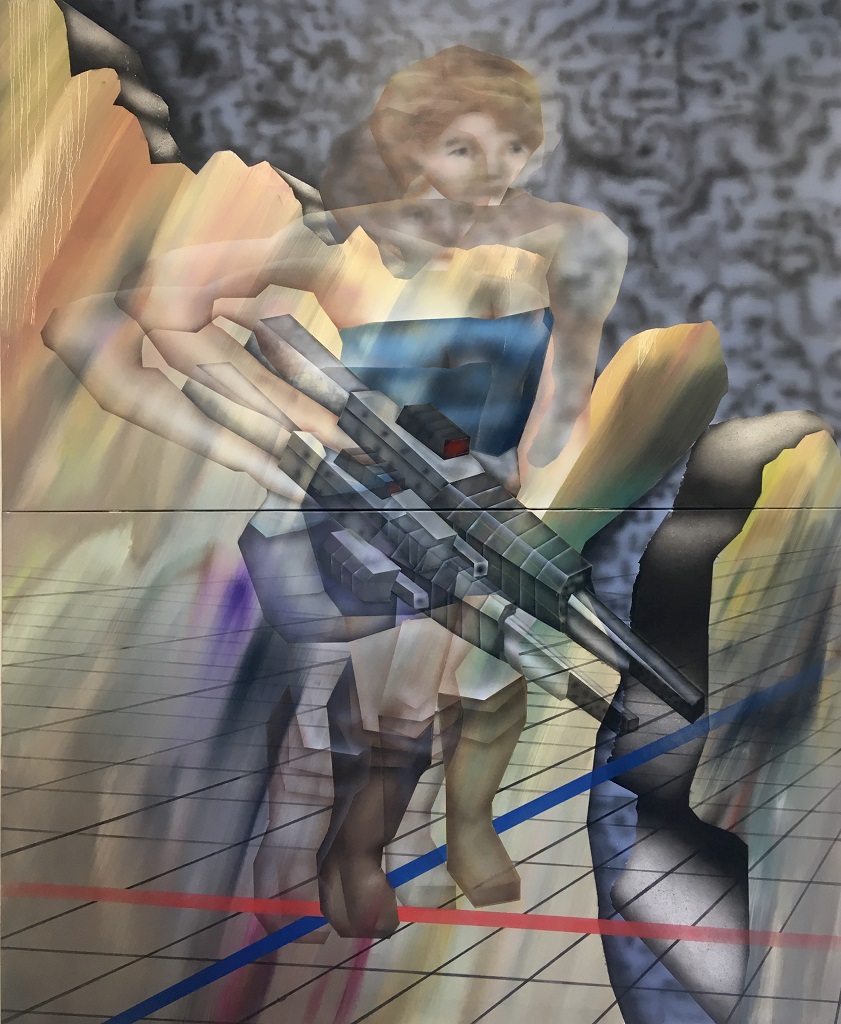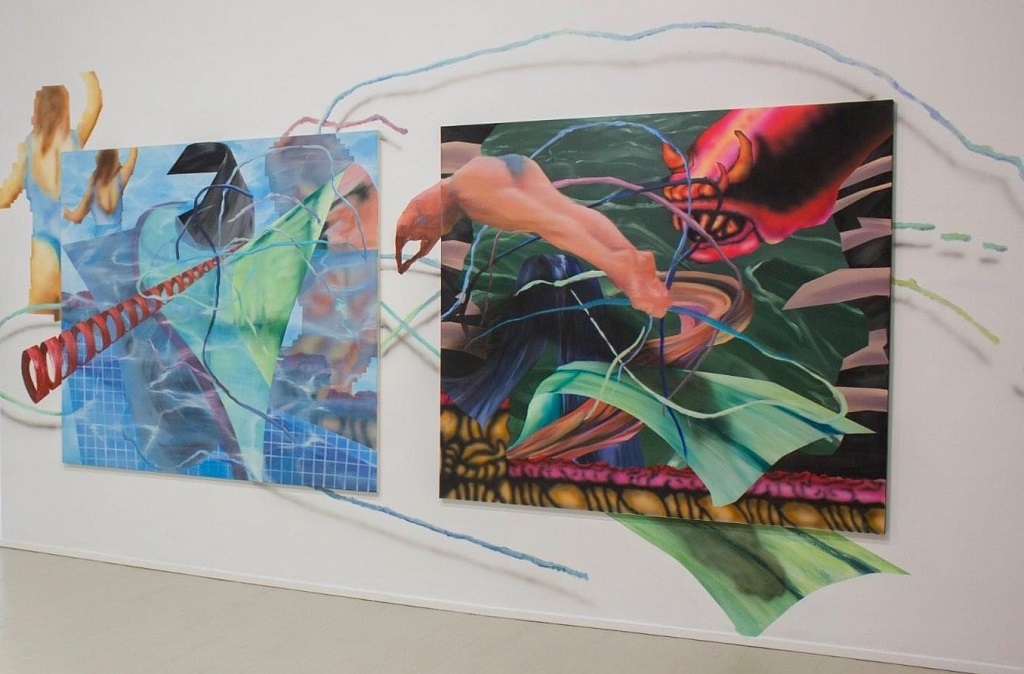Mantas Valentukonis: Virtual exhibition and Conversation with Alberta Vengrytė
Explore the virtual exhibition by Mantas Valentukonis and the conversation between the artist and contemporary art critic and historian Alberta Vengrytė. The two discuss about Mantas’ works, creative processes and influences of virtuality which determine his canvases.
ALBERTA VENGRYTĖ: The canvases you create combine the spaces of reality and digitality. In the end of 20th century – beginning of 21st century, when technologies established themselves as culturally dominant, the possibilities opened up as never before to freely manipulate essential socio-epistemic concepts, such as the self, body, space, time, memory, liveness, virtuality, nowness, documentality, etc. This is also evident in the aesthetics of your works. What is your relationship with technology as an artist? Could you describe the worldview in which the motifs of your paintings are born? What would you say if I asked you what you consider the technological identity of your paintings? Is it determined by the technique or the motive?
MANTAS VALENTUKONIS: I aim for any digital technology to be able to serve me in the creative process and I allow myself to be determined by its effect while creating a picture, choosing motifs for it. The processes of image processing programs, ‘video games’, ‘CGI’, ‘Augmented Reality’, ‘photogrammetry’, ‘Artificial Intelligence to photos’ and their results already have their own visual charge or ‘fashion’ (visual trend), so I research and I experiment with the technology itself, thereby extracting a visual language that could visually become a work of art. When creating a visual motif, I draw attention to forms ‘taken’ from reality, but at the same time conceptually or visually distant from it, connecting them with synthetic surface conditions (texture – surface condition), the nature of which is cyberspace. Such confusion of materiality/immateriality creates intrigue and distance between the viewer and the work. I think that the motive and the chosen technique by which it is expressed determine the autonomy and individuality of the work in relation to each other. The technique defines the nature of the motif, and also erases (explores) the boundary between painting and digital image, so I seek to experience that boundary most when creating a painting.

Mantas Valentukonis
Madonna, 2022
A.V.: The matrixes of realism and virtuality in your works conflict in a certain sense – often the overlapping planes of the picture are distinguished by different painting techniques, thus highlighting the visual and conceptual difference between the two. However, the figures seen in the canvases are almost always digital, not belonging to the realm of physical reality alone. Such play of vital and non-vital elements of the picture seems to create a transductive relationship – transferring information of a different nature between the selected motifs. The narrative of the painting that emerges from this relationship also includes at least two different planes – the digital and the real. How does the picture’s narrative time function in this context? What technological or conceptual solutions help to ensure the unity of the parts of the work in such a meta-stable relationship? Or maybe this story is not concise at all?
M.V.: While creating a painting, I hope that ideas that are distant from each other will grow into a new organic whole (‘grafting’). The target audience is important, as the works are overflowing with references to cyber culture: video game avatars, photoshop layers, post-photographic method photogrammetry (when photography becomes a qualitatively new, technology-dependent concept), textures, etc., therefore, it becomes clear that the time of the story is about – today. Computer games, especially the old ones, such as: Doom, Wolfenstein, DukeNukem, Quake, Max Payne, Resident Evil, Silent Hill, etc., with their narrative, avatar portraits, expressed in the typical visual language of that time, from a modern perspective are full of irony, clichés, stereotypes, it is a concentrated reflection of pop culture, the society we live in today. When painting a picture, I think about the fact that it is a pixelated screen. In it, I am not trying to depict light and dark in
order to create the impression of space, I rather paint something that is not real and that is based on other constraints than we face in reality, so I aim at the painting “lighting up” by itself, this establishes equality between the parts of the work.
A.V.: When we talk about the overlap between reality and virtuality, we often think about a certain “collapse” of reality in the realm of virtuality. Such a feeling pervades a considerable part of the most famous cultural theoreticians of the 2nd half of the 20th Century. However, in the 3rd decade of the 21st Century we seem to increasingly abandon the overarching idea of a cultural dystopia in which, as i.e.. in the 1996 texts of Mark Dery, we are talking about the genderless and germless normative future, where the only link between the technocratic elite and the technologically illiterate masses is the shopping center – and we try to positively perceive the changing structures of knowledge about the aesthetic and socio-political planes of the work of art… In some of your paintings, a gray-white grid taken over from computer image editing programs can be seen, suggesting the absence of a visual background. Arranged on the edges of the canvas, it seems to extend the plot of the painting beyond the frames of the physical format of the painting or indicates that it functions separately from the environment surrounding the painting, in a unique in between and betwixt painterly space. This is another way in which you seek to “confuse” the dimensions of reality and virtuality? Could you tell us more about the techniques used to convey the ideas of your works?
M.V.: Yes, that move from virtuality to reality and manipulating or juggling that move deepens the layering of the work and broadens the perception when looking at the work. However, at the beginning of the creative process, the sketch is born behind the screen and begins to be converted into physical form. The process often involves going back to the computer sketch and adding digital elements to the actual photo of the work-in-progress, then back to reality again, and so on until the work is finished. I do the work of transferring the sketch with a projector, sometimes when I see that the work needs an error, I do it by hand to give it imperfection. At this point, I started taking photos of the sketch on the computer screen with my phone, and moving the screen behind the screen, thus “draping” another layer on the picture. Just as the inner drama of the characters takes place in the painting, by contrasting applied and sprayed paint, or brushstroke and dust, we expect a mutual struggle in the technique itself. That dynamic movement between differently performed elements of the work incites the ambivalent feeling of the work.
A.V.: When thinking about the prototypes and repetitions of the motifs of a painting, I remember the views belonging to the same discourse of “the death of human culture in the realm of virtuality”, as if the desire for self-referential simulations caused by the medialized cultural experience manifests itself in the fading need for any original. But isn’t it the case that we enjoy images precisely because they are not the real thing; we admire them for the skill with which they were crafted. Such pleasure presupposes that the readers or viewers of the artistic text do not fall prey to mimetic illusion; they do not stop realizing that the read or seen text is just a duplicate; that what causes fascination is merely the illusionistic visual effect, the artificiality of the artificial? I speak here through the lips of the Swiss-American

Mantas Valentukonis
If it doesn’t fit, flip it, 2022
theorist Marie Laure Ryan. These thoughts of hers seem to explain to me the duality of the motifs seen in your paintings – they are neither purely physical, nor technical, nor real, nor virtual, nor completely original, nor reproduced… What kind of thoughts does the idea that when looking at your works perhaps we enjoy the universal pleasure of recognizing otherness brings?
M.V.: Each motif placed in a foreign context or space acquires different forms, becomes ‘something else’, independent and universal. For me, those characters are rather symbols or metaphors, which contain the necessary load of emotional or cultural context and are able to “communicate” with the viewer. How much the character itself is important to me, I can’t answer, maybe I myself in that picture am more important, because those creative decisions come from auto-biographical or certain emotional experiences, so avatars help me talk about states of mind or communicate with the viewer through them. Still, the final picture in my own eyes is poetic, which speaks of the non(reality) we see in movies or video games.
It is a nice idea about the universal recognition of otherness. I think spontaneity, intuition contributes to this state. I felt the same way when I discovered the 1998 video game ‘LSD-Dream Emulator’. At that time, it seemed that the game was basically alien compared to others, both in its aesthetic language, purpose and management, it was incomprehensible to the mind, but it was through ‘inner knowledge’ that I managed to merge with it.

Mantas Valentukonis
Watercolours, 2021
A.V.: How does pictorial intimacy correlate with digital anonymity? One of the most beautiful moments of your work for me is precisely this seemingly simple contrast. The motif taken from the digital environment is reinterpreted and reborn on the canvas by the means of painting and handwork… Could you tell us more about your creative process? What a typical day looks like in your studio (or wherever you paint)?
M.V.: I’m not sure if it correlates unanimously. On the one hand, the picture lets you “enter” itself, on the other hand, it maintains a distance with its screen properties. Perhaps, rather, pictorial intimacy and digital anonymity offer an experience of ambivalent feelings. Even before coming to the studio, I have already planned at which stage of the process I will make a painting error, for the intimacy you mentioned, or how and in what way I will repeat certain painting areas. I am already in the painting process much earlier than I physically start painting. I have noticed that it is very easy to become obsessive about a picture, probably it’s the influence of technology.
A.V.: During your studies, you met and started collaborating with the painter Šarūnas Baltrukonis, as we speak, you are preparing for a joint exhibition at the Klaipėda Center for Cultural Communications. Although the visual expression of the two is different, the works function in a really close conceptual field. This summer, you also organized a painting “battle”, during which you painted on each other’s canvases (the result of this activity is the diptych “Don’t put too much water on a fire, put just the right amount of it, it creates warm vapors”). Is the authorship of the work important to you? What other artists would you like to collaborate with in the future? Perhaps you have artist-authorities?
M.V.: Cooperation with Šarūnas started very naturally, we did not expect a collaboration to happen in advance. An important aspect for me is whether it is good to be with that person in general, if so, then some creative solutions can develop from this.
I currently feel inspired by George Rouy , Volobevza, Victoria Pidust, Hofmann Julius, Brandon Lipchik
Lithuanians : Andrius Zakarauskas, Gabrielė Adomaitytė, Rūtenė Merkliopaitė, Petras Lincevičius, Kazimieras Brazdžiūnas.

Mantas Valentukonis ir Šarūnas Baltrukonis
Don’t put too much water on a fire, put just the right amount of it, it creates warm vapors / 1vs1 painting battle, 2022
